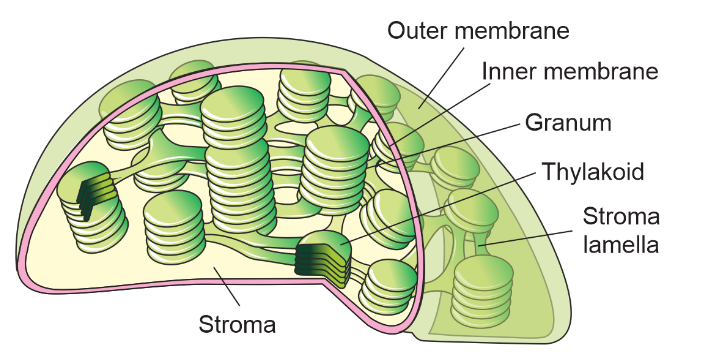Table of Contents
Introduction to Chloroplast
Chloroplasts are remarkable organelles found in plant and algae cells that play a pivotal role in capturing sunlight and converting it into chemical energy through the process of photosynthesis. They are often referred to as the “green powerhouses” of cells due to their ability to harness the energy of light and transform it into usable forms.
Definition of Chloroplast
A chloroplast is a specialized organelle found in plant cells that contain chlorophyll pigments and other molecules necessary for photosynthesis. It is responsible for the synthesis of glucose and other organic molecules using energy from sunlight.
Diagram of chloroplast

Structure of Chloroplast
Chloroplasts possess a unique and intricate structure that facilitates their vital functions. Some key structural components include:
Outer and Inner Membranes: Chloroplasts are surrounded by two membranes, an outer membrane, and an inner membrane, which help maintain the integrity of the organelle.
Thylakoid Membranes: Inside the chloroplasts, thylakoid membranes form interconnected flattened sacs called thylakoids. These membranes contain chlorophyll pigments and other photosynthetic molecules. Stacks of thylakoids are known as grana.
Stroma: The stroma is the gel-like matrix that surrounds the thylakoids. It contains enzymes, DNA, ribosomes, and other components necessary for various metabolic processes.
Stroma lamellae: Stroma lamellae, also known as intergranal thylakoids or frets, are structures found within chloroplasts. They are membrane extensions that connect thylakoid stacks, or grana, to each other. The stroma lamellae serve as a means of communication and coordination between the grana.
Also Check For:
Function of Chloroplast
Chloroplasts are primarily responsible for photosynthesis, the process by which light energy is converted into chemical energy. The main functions of chloroplasts include:
Photosynthetic Pigments: Chloroplasts contain chlorophyll pigments that absorb light energy, particularly in the blue and red parts of the spectrum, to initiate the process of photosynthesis.
Light-Dependent Reactions: Within the thylakoid membranes, chloroplasts carry out light-dependent reactions, where light energy is used to generate energy-rich molecules such as ATP and NADPH.
Calvin Cycle: In the stroma, chloroplasts facilitate the Calvin cycle, also known as the light-independent reactions. This cycle utilizes the ATP and NADPH generated in the light-dependent reactions to convert carbon dioxide into glucose and other organic compounds.
Oxygen Production: As a byproduct of photosynthesis, chloroplasts release oxygen into the atmosphere, contributing to the oxygen-rich environment essential for many organisms.
Chloroplast is a semi-autonomous cell organelle
Chloroplasts are often described as semi-autonomous cell organelles due to their unique characteristics and evolutionary origin.
Here’s an overview of why chloroplasts are considered semi-autonomous:
Independent DNA: Chloroplasts have their own circular DNA molecule, separate from the cell’s nuclear DNA. This DNA encodes genes necessary for chloroplast function and protein synthesis. It is believed that chloroplasts originated from ancient free-living cyanobacteria through endosymbiosis, wherein a host cell engulfed a cyanobacterium, establishing a symbiotic relationship.
Replication and Division: Chloroplasts can replicate and divide independently within the host cell. They have their own machinery to carry out DNA replication, transcription, and translation, allowing them to reproduce and maintain their population within the cell.
Protein Synthesis: Chloroplasts possess 70S ribosomes that resemble bacterial ribosomes in structure and function. These ribosomes are responsible for synthesizing proteins encoded by chloroplast DNA. However, chloroplasts also depend on the host cell’s nucleus for some essential proteins, as they have lost some genes through evolution.
Transcriptional Control: Chloroplasts have a certain level of control over their gene expression. They possess their own transcription and RNA processing machinery, allowing them to regulate the production of specific proteins needed for photosynthesis and other chloroplast functions.
Frequently Asked Questions (FAQs) on Chloroplast
Are chloroplasts found only in plants?
Chloroplasts are primarily found in plants and algae. However, certain protists and cyanobacteria can also contain chloroplasts.
Can chloroplasts multiply within a cell?
Yes, chloroplasts can multiply within a cell through a process called binary fission. They have their own DNA and replicate independently of the cell's nuclear DNA.
Do all plant cells contain chloroplasts?
No, not all plant cells contain chloroplasts. Chloroplasts are predominantly found in the photosynthetic cells of leaves, stems, and other green tissues where photosynthesis takes place.
How do chloroplasts capture light energy?
Chloroplasts contain chlorophyll pigments that absorb light energy. These pigments are located in the thylakoid membranes of chloroplasts and initiate the process of photosynthesis.
Can chloroplasts function in the absence of light?
Chloroplasts require light energy to carry out photosynthesis. In the absence of light, they cannot generate ATP and NADPH, which are essential for the Calvin cycle and glucose synthesis.








